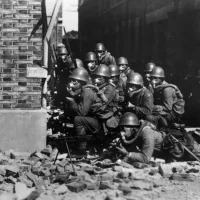Chongqing is a direct-administered municipality in Southwestern China, one of four such municipalities under the Central People's Government, and the only one located inland. Roughly the size of Austria, it includes several urban areas and is considered the largest city proper globally by population, though not the most populous urban area.
1904: Opening of Consulates
From 1896 to 1904, the American, German, French, and Japanese consulates were opened in Chongqing.
1907: Steamship Journey
In 1907, a steamship made the journey [up the Yangtze] without the help of manual haulers.
August 1933: Unofficial Record of Highest Temperature
An unofficial record of 44.0 °C (111 °F) was set on August 8 and 9, 1933.
November 1937: Provisional Capital
From November 1937 to May 1946, Chongqing was Generalissimo Chiang Kai-shek's provisional capital during and after the Second Sino-Japanese War.
1937: Wartime Capital
Chongqing was the wartime capital of China during the Second Sino-Japanese War (i.e., World War II), and from 1937 to 1945, the seat of administration for the Republic of China's government before its departure to Nanjing and then Taiwan.
1937: Second Sino-Japanese War
During the Second Sino-Japanese War (1937–1945), the city's special weather possibly played a role in protecting the city from being overrun by the Imperial Japanese Army.
1938: Bombing Campaigns Begin
From 1938 to 1943, Chongqing suffered from continuous massive bombing campaigns of the Imperial Japanese Navy and Army Air Forces.
1938: Chiang Kai-Shek retreats to Chongqing
In 1938, after the General and remaining army had lived there for a time following their retreat from the previous capital of Wuhan, it was formally declared the second capital city.
1938: Base of Resistance
In 1938, after the eventual defeat at the Battle of Wuhan, General Chiang Kai-shek and the army were forced to use Chongqing as their base of resistance.
September 1940: Formal Declaration as Second Capital City
On September 6, 1940, Chongqing was formally declared the second capital city.
December 1941: Allied Involvement
After Britain, the United States, and other Allies entered the war in Asia in December 1941, one of the Allies' deputy commanders of operations in Southeast Asia (Southeast Asia Command SEAC), Joseph Stilwell, was based in the city.
February 1943: Unofficial Record of Lowest Temperature
An unofficial record of −2.5 °C (27 °F) was set on February 8, 1943.
1943: Bombing Campaigns Continue
From 1938 to 1943, Chongqing suffered from continuous massive bombing campaigns of the Imperial Japanese Navy and Army Air Forces.
1945: End of Wartime Capital Status
Chongqing was the wartime capital of China during the Second Sino-Japanese War (i.e., World War II), and from 1937 to 1945, the seat of administration for the Republic of China's government before its departure to Nanjing and then Taiwan.
1945: End of Second Sino-Japanese War
During the Second Sino-Japanese War (1937–1945), the city's special weather possibly played a role in protecting the city from being overrun by the Imperial Japanese Army.
May 1946: End of Provisional Capital Status
From November 1937 to May 1946, Chongqing was Generalissimo Chiang Kai-shek's provisional capital during and after the Second Sino-Japanese War.
November 1949: Nationalist Government Withdrawal
Chongqing served as the KMT capital until late November 1949, when the Nationalist KMT government withdrew from the city by air.
1951: Temperature Range
Since 1951, the extremes of Chongqing's temperatures have ranged from −1.8 °C to 43.7 °C.
January 1955: Lowest Temperature
Since 1951, the extreme low temperature was recorded on January 11, 1955, at −1.8 °C (29 °F).
September 1996: Governance of Prefectures
Since September 1996, the sub-provincial city governed adjacent Fuling, Wanxian, and Qianjiang prefectures on behalf of the province.
March 1997: Separation from Sichuan Province
On March 14, 1997, Chongqing was separated from Sichuan province and made into a municipality in its own right.
March 1997: Establishment of Chongqing Municipality
On March 14, 1997, the Eighth National People's Congress decided to merge the sub-provincial city with adjacent Fuling, Wanxian, and Qianjiang prefectures and grant it independence from Sichuan.
June 1997: Official Ceremony
Chongqing Municipality's first official ceremony took place on June 18, 1997.
1997: Merging of Regions
In 1997, Chongqing merged with Fuling, Wanxian (now Wanzhou) and Qianjiang.
1997: Direct-Controlled Municipality Status
Since 1997, Chongqing has been a direct-controlled municipality in the Chinese administrative structure.
1997: Abolishment of Subdivisions
Three subdivisions were abolished in 1997 when Chongqing became a direct-controlled municipality.
2007: Religion Survey
According to surveys conducted in 2007 and 2009, 26.63% of the population practices Chinese ancestral religion, while 1.05% of the population identifies as Christian.
2009: Religion Survey
According to surveys conducted in 2007 and 2009, 26.63% of the population practices Chinese ancestral religion, while 1.05% of the population identifies as Christian.
February 2010: National Central City Designation
On February 8, 2010, Chongqing became one of the nine National Central Cities in China.
2010: OECD Metropolitan Area Population
As of 2010, the metropolitan area encompassing the central urban area was estimated by the OECD to have a population of 17 million.
2010: Muslim Population
In 2010, there were 9,056 Muslims in Chongqing.
October 2011: District Abolishment
In October 2011, Wansheng and Shuangqiao districts were abolished.
2016: Military Reorganization
In 2016, the Chengdu Military Region, which formerly included the 13th Group Army headquartered in Chongqing, was reorganized into the Western Theater Command.
2018: Population
At the end of year 2018, Chongqing's total population was 31.02 million.
2020: National Census
According to the 2020 national census, Chongqing has a population of 32,054,159, accounting for around 2.27% of the national total.
2020: Largest municipality by urban population
In 2020, Chongqing surpassed Shanghai as China's largest municipality by urban population.
2021: Urban and Rural Population
As of 2021, 70.4% of Chongqing's population is estimated to be urban, and 29.6% rural.
August 2022: Highest Temperature
Since 1951, the extreme high temperature was recorded on August 18 and 19, 2022, at 43.7 °C (111 °F).
2022: Largest City by Urban Population
As of 2022, Chongqing is the largest Chinese city by urban population, with a population of 22.80 million.
2022: GDP Statistics
As of 2022, Chongqing's nominal GDP was US$433 billion (CN¥ 2.91 trilion), about 2.41% of the country's GDP; its nominal GDP per capita was US$13,479 (CN¥90,663).
2023: Urban population
As of 2023, Chongqing had an urban population of 22.87 million.
November 2025: Planned District Abolishment
Jiangbei and Yubei districts were planned to be abolished in November 2025 along with the establishment of the formal Liangjiang New Area.
Mentioned in this timeline

Basketball is a team sport played on a rectangular court...
The United States of America is a federal republic located...

The Second Sino-Japanese War fought between China and Japan from...
World War II - was a global conflict between the...
China officially the People's Republic of China PRC is an...

War is defined as an armed conflict involving the organized...
Trending

5 months ago Kevin Love recalls Thompson hug, advocates mental health as free agency looms.

7 months ago Max Christie's Connection to Doug Christie Explored Amid Mavericks' Winning Streak.

Zooey Deschanel is an American actress and musician known for her deadpan comedic roles She debuted in film in and...

Phillip Louis Maton III is a professional baseball pitcher currently playing for the Texas Rangers in MLB His MLB career...

45 minutes ago Tate McRae releases trippy 'Nobody's Girl' video and 'Anything But Love' gains attention.

8 months ago JT Toppin's rise fuels Texas Tech's March Madness hopes; connection to Obi Toppin explored.
Popular

William Franklin Graham III commonly known as Franklin Graham is...

XXXTentacion born Jahseh Dwayne Ricardo Onfroy was a controversial yet...

Cristiano Ronaldo often nicknamed CR is a Portuguese professional footballer...

Candace Owens is an American conservative political commentator and author...

Marjorie Taylor Greene known as MTG is a far-right American...

Michelle Obama is an American attorney author and former First...